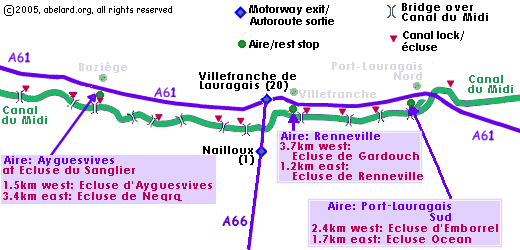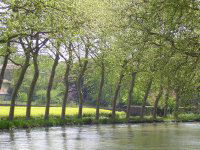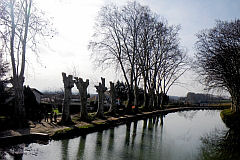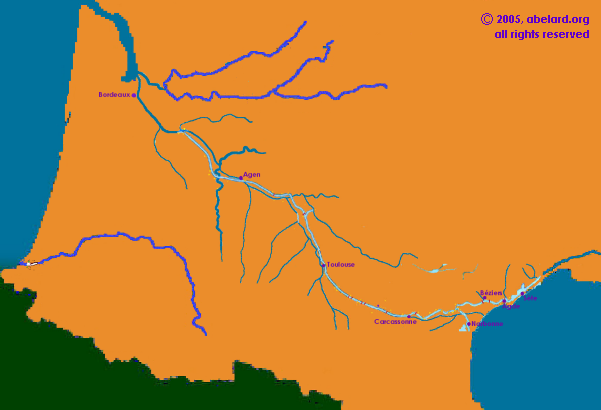france
new! Cathedrale Saint-Gatien at Tours 
 updated: Romanesque churches and cathedrals in south-west France updated: Romanesque churches and cathedrals in south-west France
the perpendicular or English style of cathedral 
the fire at the cathedral of Notre-Dame de Paris

cathedral giants - Amiens and Beauvais
Stone tracery in church and
cathedral construction 
stone in church and cathedral construction stained glass and cathedrals in Normandy  
fortified churches, mostly in Les Landes
cathedral labyrinths and mazes in France
using metal in gothic cathedral construction
Germans in France
cathedral destruction during the French revolution, subsidiary page to Germans in France

on first arriving in France - driving
France is not England
paying at the péage (toll station)

Transbordeur bridges in France and the world 2: focus on Portugalete, Chicago,
Rochefort-Martrou
Gustave Eiffel’s first work: the Eiffel passerelle, Bordeaux
a fifth bridge coming to Bordeaux: pont Chaban-Delmas, a new vertical lift bridge
France’s western isles: Ile de Ré
France’s western iles: Ile d’Oleron
Ile de France, Paris: in the context of Abelard and of French cathedrals
short biography of Pierre (Peter) Abelard
Marianne - a French national symbol, with French definitive stamps
la Belle Epoque
Grand Palais, Paris


Pic du Midi - observing stars clearly, A64
Carcassonne, A61: world heritage fortified city
Futuroscope
Vulcania
Space City, Toulouse
the French umbrella & Aurillac
50 years old:
Citroën DS
the Citroën 2CV:
a French motoring icon
the forest as seen by Francois Mauriac, and today
Les Landes, places and playtime
roundabout art of Les Landes
Hermès scarves

bastide towns
mardi gras! carnival in Basque country
country life in France: the poultry fair
what a hair cut! m & french pop/rock

Le Tour de France: cycling tactics 
| Motorway
aires are designed to provide a suitable environment for relaxing,
refreshing and recovering during the long, hard journeys. As well
as facilities of often dubious nature, picnic tables and seats,
a telephone kiosk, there are often optional extras such as a play
area or a display related to some local interest or event. port-lauragais
and two neighbouring aires
Aires on the A61 autoroute next to
the Canal du Midi.
This map shows three
consecutive aires, on south [east-bound] side of the A61 autoroute
that borders on the Canal du Midi. From each of the aires, you
may walk out onto the path alongside the Canal [extent of this
path beyond this region not verified]. In each case, should you
feel like a stroll along the canal, we have indicated the nearest
lock [écluse], and its distance, in each direction from
the aire. We have also marked bridges and other locks along this
stretch of the Canal. The canal banks also provide a pleasant
environment for a picnic. ayguesvives
aire The aire d’Ayguesvives is
small, and right next to the great Canal du Midi. A small gate
next to the shaded, red-brick picnic seats and tables leads to
the Canal du Midi, with the Ecluse [Lock, in English] du Sanglier
hard by. All along the canal is a path for both walkers and cyclists.
This little aire has cooling showers and a little children’s
play area. renneville
aire Renneville is another quiet, small
aire right next to the Canal du Midi. There are wooden picnic
tables next to the canal-side path, through a little gate from
the aire’s parking area, together with an organically-contructed
wood bench. The next locks are a walk away in either direction,
as shown above on our map.
port-lauragais
aire Port-Lauragais sud is an
open and windy aire, with four or five windmills in the distance.
There is a substantial shop selling a variety of attractive and
tempting local products - wines, violets of Toulouse: perfume,
essence, cachets; items made from Pastel blue dyestuff (the French
name for woad; traditionally used for French military uniforms),
foods and clothes. The Rugby Museum was closed when abelard.org visited,
with no indication when it might be open. During the summer,
at the weekend, there are free ‘introductions’ to
a range of sports, such as golf, fencing, sailing.... The
aire also includes a spacious lake and an inland harbour that
is connected to the Canal du Midi. From here you may take boat
excursions. The Lauragais Port was excavated during the
construction of the A61 autoroute in the 1980s. the
canal du midi
january 2011 - the canal’s
plane trees under attack

Now a UNESCO World Heritage monument, the 240 km Canal du Midi
was built in the seventeenth century to join the Garonne River
to the Mediterranean Sea. One of the enduring memories for its
visitors is the canal lined by more than 40,000 mature plane trees,
most now well over 150 years old. A further 22,000 planes line
the Canal
des deux mers that joins the Garonne to the Atlantic
Ocean. Caused by a microscopic fungus - plane and sycamore
coloured canker (Ceratocystis fimbriata platani form),
it made its first appearance along the Canal du Midi in 2006.
This fatal and infectious disease is now notably attacking the
plane trees lining the Canal. There is no known treatment against
the disease, so the only recourse is to cut down both diseased
and nearby, possibly infected, healthy trees. The disease spreads
mainly through the interconnecting roots of neighbouring trees.

To
stem this epidemic, the canal authorities have announced a cull
of about two thousand trees. Because the disease spreads so easily,
it is necessary to not only burn the branches and trunks, but
also dig up and burn the roots, as well as disinfecting the soil
in which the trees grew. As a result, much of the affected canal
banks will have to be consolidated, the planes maintaining the
canal’s banks, as well as reducing water evaporation and
providing welcome shade for boaters. The disease now is
spreading from Castelnaudary in the département
of Aude, to the canal’s start in Thau lagoon on the Mediterranean
Sea. It also affects the canal connecting the Canal du Midi to
the Canal de la Robine which goes to Narbonne. It will be
ten years before replanting can begin and a hundred years for
the new trees to grow to such maturity. The canal is lined
by nearly 230,000 trees, of which 60,000 are planes, mainly in
the stretch between Toulouse and Bezier. [The fungus was
introduced on contaminated US Army wooden crates during the 2nd
World War. It had been identified in the USA in 1929. This canker
now also affects Greece and Switzerland.]
2022 update on the canal’s
plane trees under attack
Now, eleven years after the disease problem in the Canal du Midi's plane trees became obvious, seven out of ten trees have been uprooted, that is 32,600 diseased trees uprooted along 240 kilometres. 11,600 trees have already been felled in Hérault, 18,900 in Aude and 280 in Haute-Garonne. In 2011, the cull was announced then to be merely 2,000 trees.
Sick trees, impossible to save and now structurally dangerous because they have been weakened by canker stain, a devastating microscopic fungus. This fungus (Ceratocystis platani) enters the tree through wounds in the trunk or roots and then colonizes the tissues very quickly. Uprooting then becomes the only solution in the hope of saving the others. Trees contaminated since 2006 are then burned on site to prevent the spread of this disease. 16,000 trees have already been removed since 2011 . Others will be removed in February 2023.
More resistant species are replanted each year. For the whole of this project, more than 200 million euros will be necessary to pay for the uprooting, planting and renovation of the banks.
Much of the replanting is trees 4 metres high such as oaks or hackberries. Obviously, it will take decades before these are no longer spindly. To help the bird population, 1,300 nesting boxes are being placed to protect birds and allow them to reproduce there
Inevitably, the way the Canal looks is not what it used to be. This is the case, for example, in Villeneuve-les-Béziers. The hundred-year-old trees have disappeared, replaced by plants. And walkers along the Canal all recognise that the Canal du Midi today has nothing to do with the postcards that everyone knows.
To date, 57 kilometres of banks have been renovated out of the 480 that make up the canal. The Canal du Midi extends over 240 kilometers between the Etang de Thau, near Sète, and Toulouse. It is extended to the Atlantic by the side channel of the Garonne over 193 kilometres. The set of these two canals as well as their branches and ramifications is called "The Canal of the Two Seas". | The
Canal dub Midi, stretching from the Atlantic Ocean to the Mediterranean
Sea, is divided into three sections: the Canal
du Midi with 70 locks, the Lateral
canal with 53 locks, and the Garonne River with 2 locks. In all,
this canal system is almost 500 km long. (The Garonne is the large
river whose mouth opens near the Atlantic coastal city of Bordeaux.) Built
between 1666 and 1681, during the reign of Louis XIV, the Midi
Canal is the oldest working canal in Europe. It extends 150 miles
(240 km) from Thau lake (near Sète on the Mediterranean
coast) to Toulouse. There has been little change in this canals
design and functioning since the seventeenth century. In
1856, 120 miles (192 km) of the Lateral Canal was completed, so
joining the Canal du Midi to the Garonne River, and thence to
the Atlantic Ocean. Thus, the French fleet no longer needed to
pass through the Straits of Gibraltar. The Canal’s
designer was was Pierre-Paul Riquet. The
man and his work has been commemorated by the Obelisque du Riquet,
set in parkland, about 2 km to the north-east of the Port-Lauragais
aire. The Canal was classified by UNESCO as a World Heritage Site
in 1996. The Midi Canal comprises 382 engineering structures,
including 125 locks, together with weirs, aqueducts, bridges,
tunnels and siphons.[3] It used both by over
a thousand sea-going vessels a year and over 450 hire boats and
barges, as well as floating hotels.[4] It is
a very attractive, quiet and often shaded, long aquatic park.
Its minimum depth is 1.39m (4ft 6ins), while minimum lock size
is 30.5m (100ft1in) x 5.34m (17f.6ins). The locks are closed on
French national holidays: January 1, May 1, July 14, November
1, November 11, December 25. 
The canal du Midi


Sketch
map locating the Ayguevives, Renneville and Port-Lauragais
aires The Port-Lauragais
sud aire and its facilities is directly accessible from the east-bound
side of the A61 motorway, when going towards Carcassonne and the
Mediterranean Sea. If you are approaching from the east (from
Carcassonne, the Mediterranean Sea) there is a tunnel under the
motorway from the Port-Lauragais nord aire. The Ayguevives
and Renneville aires are both located on the east-bound (south)
side of the A61, only being accessible from that side of the motorway.
These three aires are in Département 31 - Haute-Garonne. 
end notes - aire:
in this context, an area —
aire de loisirs:
recreation area;
aire de pique-nique: picnic area;
aire de repos: rest area;
aire de services:
services , motorway (GB) or freeway (US) service station.
- Baron Pierre-Paul
Riquet de Bonrepos
born 1604, Béziers, France,
died 1 October 1680, Toulouse
French public official and self-made
engineer who constructed the epochal 150-mile (240-kilometre)
Canal du Midi (also called the Languedoc Canal) connecting the
Garonne River to the Aude River, thus linking the Atlantic and
the Mediterranean. The canal has been called the greatest civil
engineering project in Europe from Roman times to the 19th century.
A tax collector under Louis XIV, Riquet interested himself
in the long-discussed problem of constructing a navigable waterway
to provide a shortcut from the Bay of Biscay to the Mediterranean.
In 1662 he laid a proposal before Jean-Baptiste Colbert, Louis
XIV's finance minister. Through Colbert's influence, Riquet obtained
from the province of Languedoc loans that permitted him to carry
out the work, which required many locks, a reservoir to provide
water for the summit section during the dry season, and the famous
Malpas Tunnel, where Riquet became the first engineer to use an
explosive (black powder) for blasting rock. Worn out by his labours,
he died while executing the final work on the harbour of Cette
(modern Sète) at the Mediterranean terminus. The canal
opened the following year (1681).
Copyright 1994-1998 Encyclopaedia Britannica
- Some
technical data on the Canal du Midi
The Canal rises
206 feet (63 m), by means of 26 locks, in the 32 miles (51.5-kilometres)
from Toulouse to Seuil de Naurouze, the summit of its route. The
Canal then runs 3 miles (5 km) along the summit. Then it descends
620 feet (189 m) over a distance of 114 miles (183.5 km), helped
by 74 locks. Pierre-Paul Riquet overcame a rocky rise near Béziers
by a then untried method, using black powder to blast a 515-foot
(157-metre) tunnel, 22 feet (6.7 m) wide and 27 feet (8 m) high.
This was the first canal tunnel to be built like this and the
first time explosives were used in underground construction.
- Maximum specifications for boats
using the Canal du Midi
( Boat size restrictions - all measurements
in metres)
Boat length : 30.00
Boat beam : 5.05
Boat
height above water : 03.00
Boat keel depth : 1.60 |
advertising disclaimer
|
























